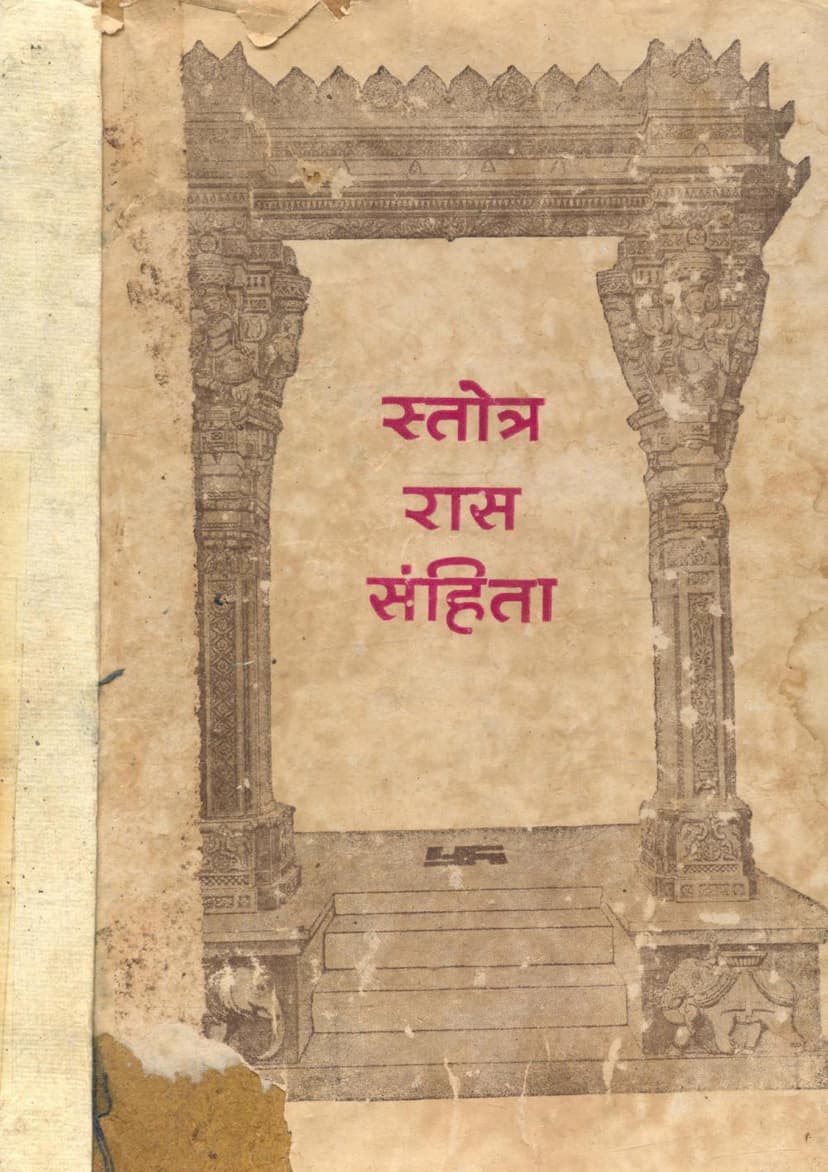Stotra Ras Samhita
Added to library: September 2, 2025

Summary
Here's a comprehensive summary of the Jain text "Stotra Rasa Samhita" based on the provided pages:
Book Title: Stotra Rasa Samhita (स्तोत्र रास संहिता)
Authors: Muni Shri Lalitaprabhsagar (compiler), Muni Shri Chandraprabhsagar (editor), Shri Bhanvarlal Nahta
Publisher: Siddhiraj Jain, Calcutta
Publication Year: 1986
Core Theme: The "Stotra Rasa Samhita" is a compilation of various Jain devotional hymns (stotras) and devotional songs/narratives (rasas). Its primary purpose is to facilitate Bhava Puja (internal devotion, praise, and contemplation) towards the Tirthankaras (Jain spiritual leaders) and other revered souls in Jainism. The text emphasizes that true devotion is an internal process of appreciating the virtues and teachings of these exalted beings, leading to self-realization and spiritual progress.
Key Concepts and Philosophies:
- Tirthankaras as Beacons of Light: The preface highlights Tirthankaras as "niratisay prakash-stambh" (unparalleled beacons of light) on the path of spiritual discipline. They are considered Veetaraga (free from passions) and Sarvajna (omniscient) who sow seeds of righteousness and preach ethics and morality for the development of human civilization and culture.
- Devotion as a Means of Self-Realization: The text strongly advocates that praising and worshipping Tirthankaras is essential for realizing one's true self and the inherent divine potential within. Just as a lion cub raised by sheep recognizes its leonine nature upon seeing a lion, individuals can uncover their Jinatva (divine essence) through devotion.
- True Devotion is Internal (Bhava Puja): The book distinguishes between two forms of worship:
- Dravya Puja (Material Worship): Offering sacred items to the image or representation of a Tirthankara.
- Bhava Puja (Internal Worship): Glorifying and singing the great virtues of the Tirthankaras. The text states that Bhava Puja is supreme, and even in Dravya Puja, the internal feelings and intentions are paramount. While lay followers are encouraged to perform both, ascetics are guided to focus solely on Bhava Puja.
- Tirthankaras as Ideals, Not Givers: The preface clarifies that Tirthankaras and Siddha Bhagwans are ideals and sources of inspiration, not entities from whom worldly achievements are to be expected. They are liberated beings; their role is not to bestow or liberate others directly, as that is the outcome of one's own spiritual efforts.
- Benefits of Stotra Chanting: Devotional chanting (stotra chanting) is presented as a means to shed negative tendencies (kashaya) and cultivate and enhance virtues.
- Compilation of Scattered Material: This book aims to collect and present various scattered materials related to Bhava Puja in a comprehensive, universally applicable, pure, and beautiful manner.
Content Overview (Indicative of the vastness):
The book is structured with various sections dedicated to different types of prayers and devotional literature. Based on the table of contents and the initial pages, the book includes:
-
Stotras (Hymns): A significant portion of the book is dedicated to a wide array of stotras. These are hymns praising various Jain Tirthankaras and other important figures. Examples include:
- Mangalsutra (auspicious prayer)
- Various stotras for Ajitshanti, Parshva, Tirthankaras (e.g., Chandraprabha, Rishabhdev, Parshvanath), and the Jina Panchjara.
- Stotras praising learned individuals and spiritual guides (Gurustotras, e.g., Gautam Swami, Jinadatta Suri).
- Stotras for specific purposes like protection (Atmaraksha), peace (Shanti Stotras), and warding off malefic influences (Graha Shanti).
- Hymns dedicated to Goddess Saraswati.
- The renowned Bhaktamara Stotra and Kalyanamandira Stotra.
- Mantras and powerful stotras like Mantradhiraja.
-
Rasa (Devotional Songs/Narratives): The book also includes devotional songs or narratives known as "rasas," which often recount the stories, virtues, and miracles associated with Jain figures. Examples provided include:
- Gautam Swami Ji ka Rasa
- Shatrunjaya Tirth ka Rasa
- Dada Shri Jinadatta Suri Stotra (likely a Rasa or a related devotional piece)
- Dada Guru Gun Ikateesa (Thirty-two Virtues of the Dada Guru)
Notable Aspects:
- Extensive Coverage: The book appears to be a comprehensive collection, listing numerous stotras covering a wide range of devotional needs and subjects within Jainism.
- Focus on Virtue and Self-Improvement: The underlying message is consistent: the purpose of these hymns is not merely ritualistic recitation but a path to spiritual purification, virtue development, and self-realization.
- Historical and Religious Significance: The compilation represents a significant effort to preserve and disseminate important Jain devotional literature.
- Gratitude and Support: The inclusion of a "Publication Support" page indicates that the printing and distribution of this book were likely made possible through the generosity and contributions of various individuals and organizations within the Jain community.
In essence, "Stotra Rasa Samhita" is a rich repository of Jain devotional poetry and prose, designed to guide practitioners towards deeper internal devotion, understanding of Jain principles, and ultimately, spiritual liberation.